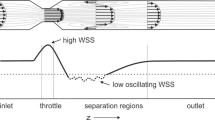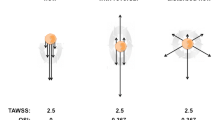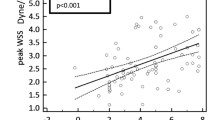Abstract
Endothelial shear stress (ESS) dynamics are a major determinant of atherosclerosis development. The frequently used Poiseuille method to estimate ESS dynamics has important limitations. Therefore, we investigated whether Womersley flow may provide a better alternative for estimation of ESS while requiring equally simple hemodynamic parameters. Common carotid blood flow, centerline velocity, lumen diameter and mean wall thickness (MWT) were measured with 3T-MRI in 45 subjects at three different occasions. Mean ESS and two measures of pulsatility [shear pulsatility index (SPI) and oscillatory shear index (OSI)] were estimated based on Poiseuille and Womersley flow and compared to the more complex velocity gradient modelling method. The association between ESS and MWT was tested with multiple linear regression analysis; interscan reproducibility was assessed using intraclass correlation coefficients (ICC). Mean ESS and pulsatility indices based on Womersley flow (ESSwq β = −0.18, P = 0.04; SPIwq β = 0.24, P = 0.02; OSIwq β = 0.18, P = 0.045), showed equally good correlations with carotid MWT as the velocity gradient method (ESSvg β = −0.23, P = 0.01; SPIvg β = 0.21, P = 0.02; OSIvg β = 0.07, P = 0.47). This in contrast to the Poiseuille flow method that only showed a good correlation for mean ESS (ESSpq β = −0.18, P = 0.04; SPIpq β = 0.14, P = 0.14; OSIpq β = 0.04, P = 0.69). Womersley and Poiseuille methods had high intraclass correlation coefficients indicating good interscan reproducibility (both ICC = 0.84, 95 % confidence interval 0.75–0.90). Estimation of ESS dynamics based on Womersley flow modelling is superior to Poiseuille flow modelling and has good interscan reproducibility.


Similar content being viewed by others
Abbreviations
- 3T-MRI:
-
3.0 Tesla magnetic resonance imaging
- ESR:
-
Endothelial shear rate
- ESS:
-
Endothelial shear stress
- ICC:
-
Intraclass correlation coefficient
- LA:
-
Lumen area
- MWT:
-
Mean wall thickness
- OSI:
-
Oscillatory shear index
- Q:
-
Blood flow rate
- SPI:
-
Shear pulsatility index
- v:
-
Centerline velocity
References
Davies PF (2009) Hemodynamic shear stress and the endothelium in cardiovascular pathophysiology. Nat Clin Pract Cardiovasc Med 6:16–26. doi:10.1038/ncpcardio1397
Tzima E, Irani-Tehrani M, Kiosses WB, Dejana E, Schultz DA, Engelhardt B, Cao G, DeLisser H, Schwartz MA (2005) A mechanosensory complex that mediates the endothelial cell response to fluid shear stress. Nature 437:426–431. doi:10.1038/nature03952
Dai G, Kaazempur-Mofrad MR, Natarajan S, Zhang Y, Vaughn S, Blackman BR, Kamm RD, García-Cardeña G, Gimbrone MA (2004) Distinct endothelial phenotypes evoked by arterial waveforms derived from atherosclerosis-susceptible and -resistant regions of human vasculature. Proc Natl Acad Sci USA 101:14871–14876. doi:10.1073/pnas.0406073101
Langille BL, O’Donnell F (1986) Reductions in arterial diameter produced by chronic decreases in blood flow are endothelium-dependent. Science 231:405–407. doi:10.1126/science.3941904
Duivenvoorden R, Vanbavel E, de Groot E, Stroes ES, Disselhorst JA, Hutten BA, Laméris JS, Kastelein JJ, Nederveen AJ (2010) Endothelial shear stress: a critical determinant of arterial remodeling and arterial stiffness in humans–a carotid 3.0-T MRI study. Circ Cardiovasc Imaging 3:578–585. doi:10.1161/CIRCIMAGING.109.916304
Gnasso A, Carallo C, Irace C, Spagnuolo V, De Novara G, Mattioli PL, Pujia A (1996) Association between intima-media thickness and wall shear stress in common carotid arteries in healthy male subjects. Circulation 94:3257–3262. doi:10.1161/01.CIR.94.12.3257
Irace C, Carallo C, De Franceschi MS, Scicchitano F, Milano M, Tripolino C, Scavelli F, Gnasso A (2012) Human common carotid wall shear stress as a function of age and gender: a 12-year follow-up study. Age 34:1553–1562. doi:10.1007/s11357-011-9318-1
Irace C, Cortese C, Fiaschi E, Carallo C, Farinaro E, Gnasso A (2004) Wall shear stress is associated with intima-media thickness and carotid atherosclerosis in subjects at low coronary heart disease risk. Stroke 35:464–468. doi:10.1161/01.STR.0000111597.34179.47
Katritsis D, Kaiktsis L, Chaniotis A, Pantos J, Efstathopoulos EP, Marmarelis V (2007) Wall shear stress: theoretical considerations and methods of measurement. Prog Cardiovasc Dis 49:307–329. doi:10.1016/j.pcad.2006.11.001
Oyre S, Ringgaard S, Kozerke S, Paaske WP, Erlandsen M, Boesiger P, Pedersen EM (1998) Accurate noninvasive quantitation of blood flow, cross-sectional lumen vessel area and wall shear stress by three-dimensional paraboloid modeling of magnetic resonance imaging velocity data. J Am Coll Cardiol 32:128–134. doi:10.1016/S0735-1097(98)00207-1
Ford MD, Xie YJ, Wasserman BA, Steinman DA (2008) Is flow in the common carotid artery fully developed? Physiol Meas 29:1335–1349. doi:10.1088/0967-3334/29/11/008
Box FM, van der Geest RJ, van der Grond J, van Osch MJ, Zwinderman AH, Palm-Meinders IH, Doornbos J, Blauw GJ, van Buchem MA, Reiber JH (2007) Reproducibility of wall shear stress assessment with the paraboloid method in the internal carotid artery with velocity encoded MRI in healthy young individuals. J Magn Reson Imaging 26:598–605. doi:10.1002/jmri.21086
Box FM, van der Grond J, de Craen AJ, Palm-Meinders IH, van der Geest RJ, Jukema JW, Reiber JH, van Buchem MA, Blauw GJ, Group PS (2007) Pravastatin decreases wall shear stress and blood velocity in the internal carotid artery without affecting flow volume: results from the PROSPER MRI study. Stroke 38(4):1374–1376. doi:10.1161/01.STR.0000260206.56774.aa
Womersley JR (1955) Method for the calculation of velocity, rate of flow and viscous drag in arteries when the pressure gradient is known. J Physiol 127:553–563
Friedman MH, Hutchins GM, Bargeron CB, Deters OJ, Mark FF (1981) Correlation between intimal thickness and fluid shear in human arteries. Atherosclerosis 39:425–436. doi:10.1016/0021-9150(81)90027-7
Li C, Kao C-Y, Gore JC, Ding Z (2007) Implicit active contours driven by local binary fitting energy. In 06(2007):1–7. doi:10.1109/CVPR.2007.383014
Reneman RS, Arts T, Hoeks AP (2006) Wall shear stress–an important determinant of endothelial cell function and structure–in the arterial system in vivo. Discrepancies with theory. J Vasc Res 43:251–269. doi:10.1159/000091648
Ku DN, Giddens DP, Zarins CK, Glagov S (1985) Pulsatile flow and atherosclerosis in the human carotid bifurcation. Positive correlation between plaque location and low oscillating shear stress. Arterioscler Thromb Vasc Biol 5:293–302. doi:10.1161/01.ATV.5.3.293
Adame IM, van der Geest RJ, Bluemke DA, Lima JA, Reiber JH, Lelieveldt BP (2006) Automatic vessel wall contour detection and quantification of wall thickness in in vivo MR images of the human aorta. J Magn Reson Imaging 24:595–602. doi:10.1002/jmri.20662
Duivenvoorden R, de Groot E, Elsen BM, Laméris JS, van der Geest RJ, Stroes ES, Kastelein JJ, Nederveen AJ (2009) In vivo quantification of carotid artery wall dimensions: 3.0-Tesla MRI versus B-mode ultrasound imaging. Circ Cardiovasc Imaging 2:235–242. doi:10.1161/CIRCIMAGING.108.788059
Ugron Á, Paál G (2014) On the boundary conditions of cerebral aneurysm simulations. Periodica Polytechnica Mech Eng 58(1):37–45. doi:10.3311/PPme.7392
Taylor CA, Steinman DA (2010) Image-based modeling of blood flow and vessel wall dynamics: applications, methods and future directions: sixth international bio-fluid mechanics symposium and workshop, March 28–30, 2008 Pasadena, California. Ann Biomed Eng 38:1188–1203. doi:10.1007/s10439-010-9901-0
Remuzzi A, Ene-Iordache B, Mosconi L, Bruno S, Anghileri A, Antiga L, Remuzzi G (2003) Radial artery wall shear stress evaluation in patients with arteriovenous fistula for hemodialysis access. Biorheology 40:423–430
Simon AC, Levenson J, Flaud P (1990) Pulsatile flow and oscillating wall shear stress in the brachial artery of normotensive and hypertensive subjects. Cardiovasc Res 24:129–136. doi:10.1093/cvr/24.2.129
Stroev PV, Hoskins PR, Easson WJ (2007) Distribution of wall shear rate throughout the arterial tree: a case study. Atherosclerosis 191:276–280. doi:10.1016/j.atherosclerosis.2006.05.029
Struijk PC, Stewart PA, Fernando KL, Mathews VJ, Loupas T, Steegers EAP, Wladimiroff JW (2005) Wall shear stress and related hemodynamic parameters in the fetal descending aorta derived from color Doppler velocity profiles. Ultrasound Med Biol 31:1441–1450. doi:10.1016/j.ultrasmedbio.2005.07.006
Holdsworth DW, Norley CJ, Frayne R, Steinman DA, Rutt BK (1999) Characterization of common carotid artery blood-flow waveforms in normal human subjects. Physiol Meas 20:219–240. doi:10.1088/0967-3334/20/3/301
Brooks AR, Lelkes PI, Rubanyi GM (2002) Gene expression profiling of human aortic endothelial cells exposed to disturbed flow and steady laminar flow. Physiol Genomics 9:27–41. doi:10.1152/physiolgenomics.00075.2001
Malek AM, Alper SL, Izumo S (1999) Hemodynamic shear stress and its role in atherosclerosis. JAMA 282:2035–2042. doi:10.1001/jama.282.21.2035
Chatzizisis YS, Coskun AU, Jonas M, Edelman ER, Feldman CL, Stone PH (2007) Role of endothelial shear stress in the natural history of coronary atherosclerosis and vascular remodeling: molecular, cellular, and vascular behavior. J Am Coll Cardiol 49:2379–2393. doi:10.1016/j.jacc.2007.02.059
Potters WV, van Ooij P, Marquering H, Vanbavel E, Nederveen AJ (2014) Volumetric arterial wall shear stress calculation based on cine phase contrast MRI. J Magn Reson Imaging 1–12. doi:10.1002/jmri.24560
van Ooij P, Potters WV, Guédon A, Schneiders JJ, Marquering HA, Majoie CB, vanBavel E, Nederveen AJ (2013) Wall shear stress estimated with phase contrast MRI in an in vitro and in vivo intracranial aneurysm: WSS in Intracranial Aneurysms. J Magn Reson Imaging 38:876–884. doi:10.1002/jmri.24051
Mynard JP, Wasserman BA, Steinman DA (2013) Errors in the estimation of wall shear stress by maximum Doppler velocity. Atherosclerosis 227:259–266. doi:10.1016/j.atherosclerosis.2013.01.026
Acknowledgments
We would like to thank A.M. van den Berg for assisting in the data acquisition. JCVS was supported by Grant 01C-204 (EMINENCE project) from the Center for Translational Molecular Medicine.
Conflict of interest
The authors declare that they have no conflict of interest.
Author information
Authors and Affiliations
Corresponding author
Additional information
Janina C. V. Schwarz and Raphaël Duivenvoorden have contributed equally.
Electronic supplementary material
Below is the link to the electronic supplementary material.
Rights and permissions
About this article
Cite this article
Schwarz, J.C.V., Duivenvoorden, R., Nederveen, A.J. et al. Endothelial shear stress estimation in the human carotid artery based on Womersley versus Poiseuille flow. Int J Cardiovasc Imaging 31, 585–593 (2015). https://doi.org/10.1007/s10554-014-0571-0
Received:
Accepted:
Published:
Issue Date:
DOI: https://doi.org/10.1007/s10554-014-0571-0




